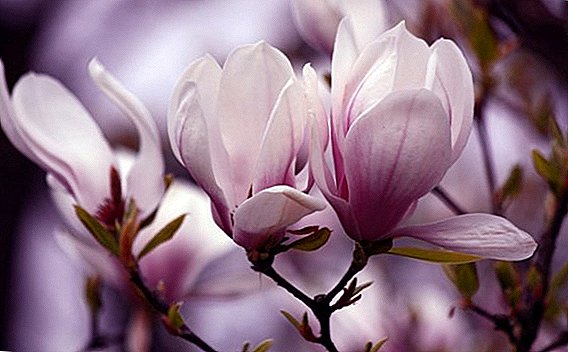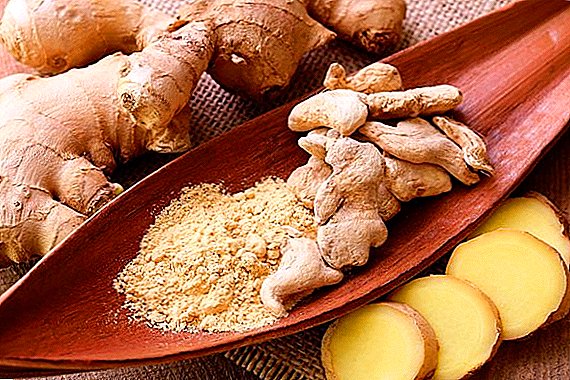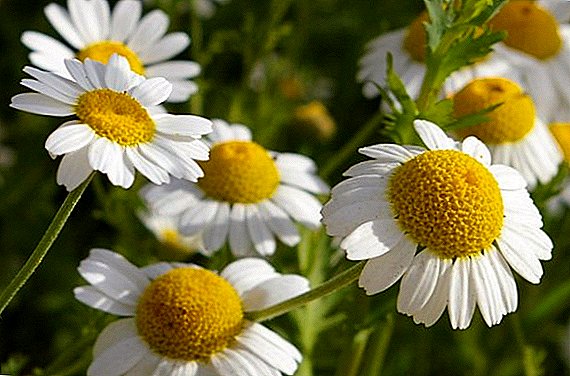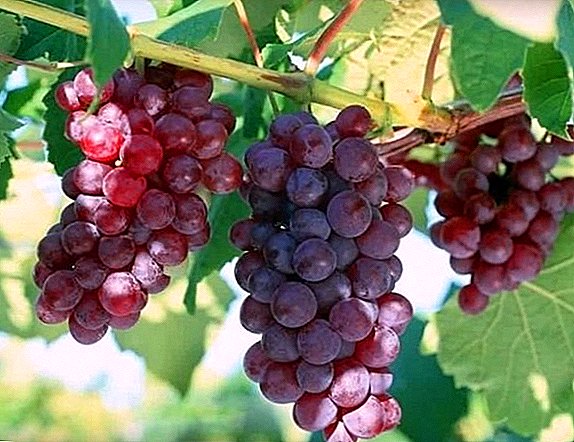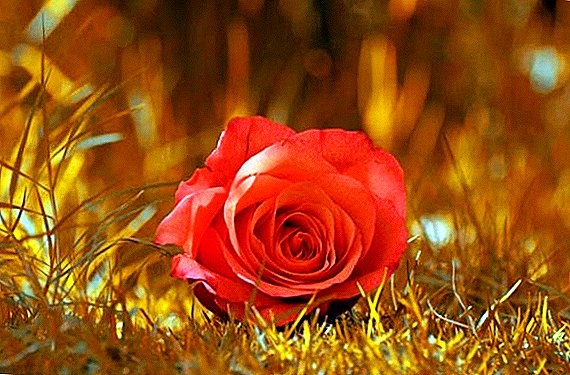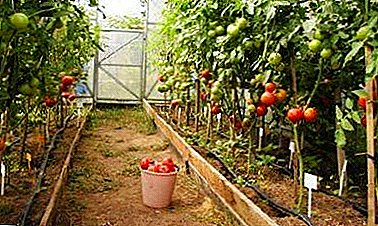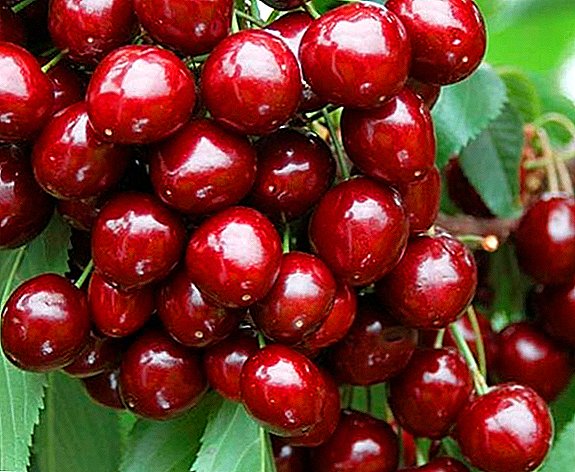 Kolonovidnye cherries - a real find for modern gardeners. This variation makes it possible to solve several problems overnight: to provide a good assortment of fruit crops in cramped areas and to harvest large yields in comfortable conditions. Now you can forget about the inaccessibility of berries on tall trees and broken branches. So let's figure out how to grow a "column" in your garden, what you need to know when planting and caring for it, and what varieties to prefer.
Kolonovidnye cherries - a real find for modern gardeners. This variation makes it possible to solve several problems overnight: to provide a good assortment of fruit crops in cramped areas and to harvest large yields in comfortable conditions. Now you can forget about the inaccessibility of berries on tall trees and broken branches. So let's figure out how to grow a "column" in your garden, what you need to know when planting and caring for it, and what varieties to prefer.
Description
In Ukraine, colony cherries, in comparison with apples and pears, are not very popular. But, according to experienced gardeners, these trees deserve attention because of their decorative, compact, early ripening and taste characteristics of fruits. 
Important! Buying seedlings of columnar cherries, carefully examine the upper point of growth. The further development of the tree depends on it. If the apical bud is damaged, the plant is doomed to death.
Outwardly, it is a low tree with a straight-growing trunk and short skeletal branches. Culture does not develop in breadth, because of what its crown is formed in the form of a cylinder.
On the cherry is not enough foliage, which is compensated by a bountiful harvest. During the fruiting period, the whole trunk is covered with berries, somewhat resembling a corn cob. But to achieve this result, the gardener should take care of a good place for planting, where there will be plenty of sunshine, as well as protection from wind and water stagnation. 
Among the advantages of columnar cultivars, owners of household plots call:
- the ability to safely cover the plant in the frosty season;
- ease of care for him (does not require the formation of the crown);
- ease of reproduction;
- probability of automated harvesting of berries;
- self-fertility;
- fast fruiting (ovary appears in the same year, after planting a seedling);
- maximum development of the crown to 1 meter in diameter.
Check out the most popular varieties of cherries: "Regina", "Bull's Heart", "Revna", "Bryansk Pink", "Krupnoplodnaya", "Iput", "Leningradskaya Chernaya", "Valeriy Chkalov" and "Diber Black".The special requirements of the cherry column are its moisture-loving and fear of nearby groundwater.

Did you know? Traditional sweet cherries can develop in height along with Christmas trees and reach a maximum mark of 25-30 meters.
Sorta
Although many gardeners had not yet had time to appreciate the benefits of columnar cherries, breeders were pleased with a large selection of varieties. Many of them have already become popular.
"CEM"
It is characterized as a high-yielding variety with large tasty red fruits. Often used for industrial purposes as a pollinator. The tree has a low crown, which develops up to 2 meters in height. Can bear fruit up to 15 years of age. Berries ripen in early summer. The variety is recommended for group plantings. 
"Sabrina"
The tree is pulled up to 2.5 meters and stands out with a branchy crown, which often reaches a volume of 1 meter. Its main characteristics are medium frost resistance and increased resistance to pests, as well as to diseases. The variety deserves attention with high yield and fruit quality. Berries ripen in the second decade of June. 
"Helena"
The variety belongs to the dessert varieties of cherries. It is distinguished by its adaptation to the climatic conditions of the temperate zone, as well as good yield and durability of the tree. The berries are characterized by a red-pink tinge of flesh and a slight harshness. They ripen closer to the middle of summer. The culture grows to a height of three meters and retains the ability to bear fruit for 25 years. 
Did you know? Colony-like tree species are of Canadian origin. Their discoverer was a local farmer who in 1964 accidentally discovered a natural mutation on an old apple tree. The tree was distinguished by a crisp branch and the absence of a crown. But, nevertheless, it was striking in its fruitfulness.
"Yellow"
The advantage of this variety are large yellow berries, which are less attractive to birds than red, as well as long-term fruiting of the tree. If the conditions are favorable for colony-like varieties, cherries will produce abundant crops for about 20 years. Its trunk develops to a three-meter height, and the crown in diameter reaches half a meter. 
"Black"
The variety is distinguished by high yield and unpretentiousness. It is recommended for regions with harsh winters, but with the condition of reliable shelter. "Black" cherry grows in height up to half a meter and is characterized by juicy ruby fruits with excellent taste. 
"Salvia"
It is popular in the middle lane. It is characterized by high fruitfulness, commodity and taste qualities of berries, as well as medium fitness at low temperatures. For the winter, the tree requires shelter. Overall dimensions are peculiar to it: the height of the trunk is up to 4 meters and the width of the crown is up to half a meter. Large fruits of ruby color ripen in late June. 
Did you know? Bees collect 35 kg of pollen from each hectare of the cherry orchard.
"Little Salvia"
It is considered an analogue of the miniature "Salvii". The tree grows up to 2 meters and does not branch. Berries do not differ in terms of ripening and coloring, but resemble the Helena variety in taste. 
"Queen Mary"
Features varieties are in the fear of frost, high yields and fruit quality. During the season, up to 15 kg of cherries can be collected from a single tree. The variety is characterized by medium size and compact crown. 
"Baby"
The name of the variety corresponds to the miniature size of the plant. It stops growing, reaching a half-meter height, and its crown in diameter develops up to 80 cm. But these characteristics do not interfere with high fruiting.
Fruits "Baby", unlike other varieties, stand out a pleasant specific aroma and sweet-sour taste. They are dark red in color. Also among the advantages of sweet cherry can be noted its high winter hardiness. But, for reliability, experts advise to take care of the timely shelter of the trunk. 
Important! To young cherry saplings are not affected by the early spring sun, experienced gardeners advise treating the trunk with lime mortar or chalk. In addition, it will help protect the tree from pests.
"Delight"
This sweet cherry deserves attention with mid-early ripening of berries, stable fruitfulness and resistance to most common diseases. The tree grows up to 2.5 meters and breadth up to 1 meter. Berries on average weigh up to 14 g, are characterized by ruby color and juiciness. Ovary appears in the third year of the seedling. 
"Iput"
The variety was loved by many gardeners due to the excellent quality and high transportability of fruits. Iputi seedlings are often preferred for industrial gardening, as the variety is characterized by high yield and ease of maintenance. Dark maroon berries are not distinguished by special sizes, but this is offset by their sweet taste, juiciness and the ability of the pulp to be easily separated from the stone. Cherry ripening period begins at the end of June. Reviews from the network about the virtues of cherry "Iput"



"Revna"
It is characterized by good keeping quality of fruits, as well as high resistance to severe winters, various fungi and sunburn. The berries are not large, but juicy and sweet. Begin to sing at the beginning of summer. 
Breeding methods
It is easy to get a colony variety of desired sweet cherry at home. In addition, this venture can be implemented in several ways. Consider them in more detail.
Grafting (stock)
To do this, you need to find a two-year cherry, which will serve as a stock. For grafting, you need to cut the petiole up to 10 cm long and in the traditional way attach it to the cut cherry stem with the base. It is important that several lower branches remain on the stock.  Reproduction of cherries grafting
Reproduction of cherries grafting
Seeding seeds
This method is more costly in time and resources. In addition, the probability of preservation of varietal characteristics does not exceed 50%. But, if you still dare to such a botanical experiment, please be patient and select the bones from the ripe berries you like. Then mix equal parts of river sand, hardwood and peat. Into the prepared substrate, deepen the seeds 1 cm, pour with warm water and cover the pots with plastic wrap for speeding shoots. It is advisable to place them in a warm place.
Take a closer look at how to grow a sweet cherry from a stone.The procedure recommended in the summer when ripe cherries. But to plant in the open ground appeared sprouts can only be in May. A year later, when the seedling is stronger, it can be moved to a permanent place in the garden.
 Reproduction of sweet sowing seeds
Reproduction of sweet sowing seedsImportant! When giving preference to colony-shaped cherries, consider their fear of cold weather. This applies to most varieties. For severe winters only single specimens are adapted. But similar trees too feel myself comfortable in a mild climate and require careful preparation for the winter.
Cuttings
This technology is used most often because it is characterized by a high survival rate of cuttings. For its implementation, it is necessary to cut the apical branches of cherries up to 10 cm long. After that, the base is treated with "Kornevin" or "Emistim".
For a quick rooting, you can leave cuttings in a container with a growth stimulator solution for several days. They are then rooted in a fresh, loose substrate. Some gardeners are advised to cover the container with polyethylene for better rooting of the future seedling.  Reproduction of cherry cuttings
Reproduction of cherry cuttings
Landing
Further development of the tree depends largely on the choice of place for it and the correctness of the planting. Let's take a closer look at all the stages that you should pay attention to.
- Only healthy seedlings with a well-developed root system and the absence of mechanical defects, as well as signs of diseases on the trunk, are suitable for planting.
- Acquired wood should be rooted as soon as possible. Otherwise, the roots may dry out and not settle down. For reliability, professionals advise to dip them into a growth stimulator, and then process them with a clay mash. This will prevent the wood from drying out.
- Look for a place to land sunny, where there is no strong winds, rain and melt water is not going to. Beware of the lowlands, because cold air always settles in them, and the sweet cherry will not like it. Also consider the location of groundwater. Ideally, they should be located at a depth of 1.5-2 meters.
- Planting can be carried out in spring and autumn. Consider that in the first variant the tree will need regular watering until it is fully rooted. And in the second - the probability of frost damage. Therefore, always take into account the temperature of the soil and air, as well as weather conditions. Autumn plantings should be planned 2 weeks before the first frosts, and spring ones - when the weather is stable and warm.
- The hole for the plant must be dug deep enough so that its roots will not be cramped. It is best of all that both the depth and the diameter are 80 cm. For mass plantings, it is recommended to retreat 1-2 meters from the neighboring crops.
- The bottom of the hole is filled with a small layer of broken brick or expanded clay, because cherries do not respond well to excess moisture, but do not like dryness either. Top poured nutrient mixture of equal parts of humus and hardwood. Potash and phosphate fertilizers can be added to it (15 g of each substance per substrate bucket).
- Then, the clay-treated roots are dipped into the prepared recess and covered with soil. At the same time, the root neck should be left at 2-3 cm above ground level. If you bury it, the tree will not grow and will die.
- Planted tree pour abundantly. If planting occurs in the spring, water should be poured until the soil is absorbed.
- Wet earth is again sprinkled with earth and thoroughly tamped. And in order to fall asleep between the root voids, experts advise to shake the cherry stem.
- The final stage of planting is reduced to making a shallow trench in the near-bar circle. This is done for easy watering.

Important! In regions with frosty winters, autumn planting is not appropriate, since the tree does not have time to settle down to the onset of cold weather. But in southern areas it is better to plan the planting in October - wet soil and moderately warm weather contribute to the adaptation of the tree, as a result of which it becomes more resistant to diseases and pests.
Care
For a stable crop of columnar cherries, experienced gardeners recommend constantly monitoring the level of soil moisture, carrying out timely preventive treatment of diseases and harmful insects, as well as taking care of the soil in the tree trunks. So step by step, let's get to the details.
Watering
Ensure that the soil in the cherry orchard does not dry out. It should not turn into a swamp, but the trees are not needed in the desert either. The first 2 years of life under the young saplings recommended daily pour out 3-5 liters of water. As plants age, the amount of moisture required will increase proportionally. But do not forget to take into account the weather conditions. After all, drenched sweet cherry will soon become a victim of fungi, bacteria and aphids.  Watering cherries
Watering cherries
Weeding and tillage in pristvolny circles
This requirement is important not only for columnar cherries, but also for all garden crops. Indeed, in the constant struggle for the nutrients of the rhizome of the trees become weak and can not fully develop. To avoid this, watch the condition of the soil in the garden.
In the spring, when the active growth of grass begins, be sure to remove all unwanted plants with a hoe and loosen the soil. Such procedures should be repeated periodically throughout the warm season.
- This improves aeration of the root system.
- The tree will have no rival for nutrition.
- The garden will start to look much tidier.
 In the fall, when the foliage falls, do not forget to remove it from the garden. This is necessary in order not to expose fruit crops to the risk of various diseases and attacks of pests.
In the fall, when the foliage falls, do not forget to remove it from the garden. This is necessary in order not to expose fruit crops to the risk of various diseases and attacks of pests.Important! So that young sweet cherries will take root well, in the first year of life necessarily remove from them inflorescences.
Top dressing
Agricultural cultivation of cherry columns provides at least 4 supplements during the growing season. In the spring, when the movement of juice begins, plants need nitrogen-containing substances. For this ideal solutions of chicken manure and mullein (in a ratio of 10: 1). It is desirable to carry out a similar top dressing in a month when the tree is preparing for flowering.  Nitrogen-containing feedings
Nitrogen-containing feedings
In the future, the cherries do not need nitrogen. It is strictly forbidden to make such fertilizers in the autumn, because they contribute to the growth of green biomass. And to the cold, young shoots will not have time to get stronger, which will lead to the death of the culture.
At the beginning of summer, the columns should be poured with a solution of urea, which is prepared in proportion: 30 g of substance per bucket of water. And in the second half of autumn, it was recommended to disperse about 300 g of superphosphate granules (the adult trees increase the dose to 400 g) and 100 g of potassium sulphate around the periphery of the trunk circle.  Urea
Urea
Consider that late feeding is the main cause of delaying the growth of shoots and reducing the hardiness of cherries.
Soil correction
Such events are held every five years. And they consist in the liming of the soil. The fact is that the acidic environment is very supportive of the development of pathogenic microbes and harmful insects. Therefore, it is important to periodically check the pH level in your area and to the extent necessary to bring it to the appropriate standards. For cherries need a neutral environment.
Чтобы узнать какая почва для растения будет наиболее благоприятной, читайте как самостоятельно определить кислотность почвы на участке.
 Определение кислотности почвы специальными приборами
Определение кислотности почвы специальными приборамиLearn about the state of the garden land at home by using 9% vinegar. To do this, take a handful of fresh substrate from a depth of 20 cm and put vinegar on it. Hiss indicates neutral acidity. But the absence of bubbles indicates the need for lime.
Important! Lime cannot be combined with nitrogen-containing feedings.On a square meter of garden area it is necessary to scatter about 150 g of lime lime. If soil correction has not been done for a long time, the amount of acid neutralizer can be increased to 300 g. As an alternative, dolomite flour and old plaster are also well recommended.
 Lime Fluff
Lime FluffPreparing for the winter
It is necessary to begin these works already from the middle of summer. Watering the plants is stopped, so as not to provoke a stunted growth and decrease in the winter hardiness of the culture. Unfortunately, many, even experienced, gardeners forget about podzimnyh moisture recharge moisture. They are very important for a safe wintering of the garden. The fact is that in freezing weather, freezing of moisture from the crown takes place. It is much easier to survive with the water in the ground. Therefore, if there is no rain in the fall, be sure to recharge the cherries with generous watering.
In addition, for a successful wintering culture need podzhivit potash-phosphate complex fertilizers. It is best to use purchased substances labeled "autumn". Their proportion is calculated in accordance with the manufacturer's instructions. 
Did you know? Cherries and cherries first appeared on the Asia Minor island in the city of Gerius, whose name is interpreted by the ancient historian Pliny as "Cherry". In Europe, these cultures became known already in 680 BC. The Roman commander Lucullus brought them there.
Young seedlings that are less than 5 years old require additional protection. Especially if they grow in regions with harsh winters. For this useful spandex, agrofibre or regular burlap. This fabric is wrapped crown, then fix the structure with a harness.  Agrofibre sweet cherry shelter
Agrofibre sweet cherry shelter
Protection against rodents
In search of food, hares and other rodents harm the bark of young plants. To avoid this, experts advise to wrap the trunk with a half-meter piece of roofing felts or to enclose a fine mesh. Also the lap tree tied to a tree copes well with this task. Just make sure that the height of such a prickly barrier is at least 50 cm.
Pruning
Every year, every spring, you need to inspect the trees and remove all branches damaged by diseases or frost. However, the structure of columnar cherries allows you to forget about the garden shears for a long time, because the tree grows only upwards and does not branch. Consequently, on your own initiative, you can form a hedge from the cherry columns, or create a bowl. How to do it right, we will tell below.
To increase the yield and longevity of the plant, learn the features of cutting cherry.

Crown formation
The uniqueness of columnar trees lies not only in the upward-growing trunk, but also in the ability to decorate your garden. At the sites of experienced gardeners you can see beautiful figures, as well as hedges of fruit bearing berry columns. Let's see what and how you can create.
Did you know? The darker the berries, the more organic acids and polysaccharides they contain.
First of all, for a successful formative pruning, professionals advise you to adhere to the following rules, which should be implemented to the best of tree growth:
- On one-year seedlings should pinch the side shoots, receding 10 cm from the trunk. It is also important to remove the top.
- Biennial colonic cherries require the removal of side branches at 20 cm from the trunk. The top is cut off when there is an increase of about 30 cm on it.
- With three-year instances, you need to remove the side branches, departing from the column by 30 cm. Also, the top of the trunk should be removed, subject to the appearance of growth.
- At 4 years of life, only side shoots are removed from the trees, which cast a shadow on the trunk.
- Beginning in the fifth year, the columnar plants cease to climb. Therefore, annually it is required to remove the top at the level of 2.5-3 meters.
- When the cherry is 6 years old, you need to remove from the column side branches on the diameter of the crown. Such a procedure should be carried out with an interval of 3 years.
 Cherry Formation
Cherry FormationDid you know? Superstitious people insist that cherries and cherries should be in every yard, because they symbolize abundance and fertility. If there is no money in the house, you can attract them with an ordinary bonfire under a flowering tree. Cherry leaves stuffed in a pillow will help expel the disease. But you need to collect them in the morning.
To form the crown on the column in several ways. Here are the most popular ones:
- Classical - provides for the intensive development of lateral shoots. Since they do not make full fruit-bearing branches, the growth is not removed.
- Hedge - the scheme works only with close planting of crops and is made by removing 10 cm of side branches each year. The method is effective only for 2-4 years, after which the crown is strongly thickened, the yield and taste of the fruit are significantly reduced.
- Cup-shaped - carried out by the annual removal of the top, the crown is formed by the side branches. The method does not work on tall columns and leads to unnecessary resource costs.

Diseases and pests
Despite the fact that breeders have taken care of the development of hardy varieties of columnar cherries, these trees still require special protection from malicious bacteria and insects.
First of all, the culture is very sensitive to pathogens of brown and perforated spot, scab, as well as tinder, fungi and viruses. In addition, caterpillars, moths, aphids and weevils love to feast on the sap of young saplings.
You can save the culture from adversity with the help of insecticidal and fungicidal preparations, as well as Bordeaux mixture. 
Did you know? Ukrainian folk beliefs say that the first meeting of a young man and girl under a cherry or a sweet cherry promises them happiness. A dreamed flowering tree promises fateful good news.
In the fight against fungi, viral and bacterial infections, the following drugs have recommended themselves well:
- Signum;
- "Quadris";
- "Horus";
- "Revus Top";
- "Ridomil Gold";
- "Tiovit Jet";
- "Topaz";
- "Switch";
- "Come on."

To destroy the colonies of harmful insects and caterpillars is best to use:
- "Inspector";
- "Balazo";
- Aktara;
- "Calypso";
- "Brunka";
- "Decis Profi";
- Actellic;
- Koragen;
- "Envidor".

Remember that any infections and attacks of pests can be avoided due to proper farming techniques. It is necessary to observe the hygiene of the soil in pristvolny circles, in time to remove the fallen leaves and carry out preventive measures. To do this, a one-time spraying of trees in the spring with any of the listed fungicides or Bordeaux mixture is enough.
If you want your sweet cherry to produce a bountiful harvest, read about sweet cherry diseases, their prevention, signs and treatment.In the event of illness, treatment is carried out according to the manufacturer’s instructions
We made sure that the columnar cherries are not difficult to grow. They will decorate any garden due to its high yield, compactness and unusual appearance. To breed them is simple, beautiful and ... delicious.
Reviews from the Internet about the benefits of cherries
Surprisingly, sweet cherry is the only product that I have never been tired of, no matter how much I ate it.
On the beneficial properties of berries can talk for a long time. The first, of course, is the improvement of the gastrointestinal tract, the prevention of constipation and light tummy. For weight loss and diets great.
It is also a source of iron and vitamin C in the complex, which makes cherries a universal and natural antianemic agent.
Children eat berries with great pleasure. For them, in addition to plant fiber, healthy juice and vitamins.
I cannot offer any recipes with cherries, for the simple reason that we have it, no matter how much it is bought, it’s all eaten to the last berry. A few jars of compote can be prepared, and then if the year is successful and something can be saved and stashed away. Smile




